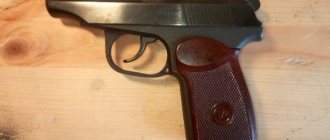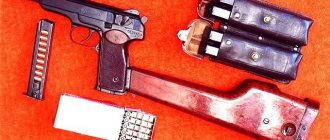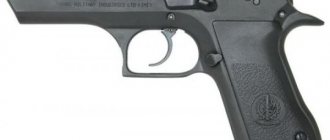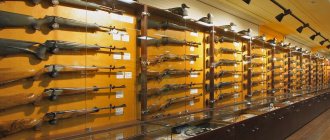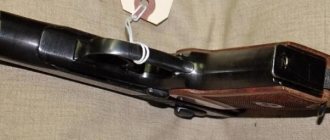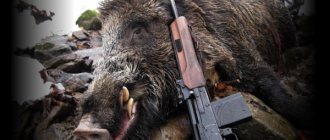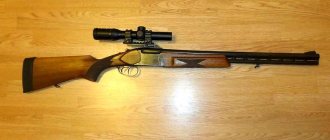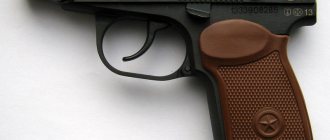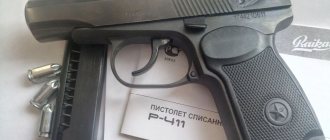Author: albin0s
11 March 2016 18:41
Tags: compact pistols
31882
11
Even those people who have a permit to carry weapons should not roam the streets with a huge revolver at the ready. So I decided to see what compact things are on the modern market.
0
See all photos in the gallery
Of course, this rating is more useful to people living in states where the free carrying of weapons is allowed, for example, in the USA. But for some, this story will be useful in Russia. In the end, we will also someday come to the concept of free self-defense, although this is a double-edged sword. So, the most compact pistols!
Features of pocket pistols
Let's touch on the main distinguishing features of small-caliber pistols:
- Ergonomics. The shape of such a weapon is always smoothed, devoid of protruding elements - the pistol will be useless if it gets stuck in a pocket or gets caught on the hem of clothing. The cocking hammers and levers are replaced with buttons, the safeties are moved to places where it is difficult to accidentally touch them, or are completely absent - the pistol is designed to be self-cocking.
- Using ammunition of the same caliber as the service weapon. Such an increase in the power of a ladies' pistol does not give any reason to consider it a toy.
- Miniature mechanism. This feature leads to obvious inconveniences - the handle is sometimes difficult to hold with your little finger. Manufacturers solve this problem in different ways - they lengthen the magazine, move it forward and down under the chamber.
Walter
The ladies' pistol "Walter" is a classic small-caliber weapon. , founded in 1886, began producing similar devices in 1911. And it was pocket pistols that brought the company worldwide fame.
A total of five models of Walter mini-revolvers were produced:
- The first was compact and light, had an open bolt-casing and a percussion type mechanism. The magazine held 6 rounds of 6.35 mm.
- The next version, patented in 1913, had a hidden hammer, and its rear sight served as an indicator of the presence of charges in the chamber.
- The third version of the small Walter pistols was a rarity (only 3,500 units were produced). It was distinguished by an increase in caliber to 7.65 mm and had an annoying drawback: cartridges ejected through the side window came into the shooter’s field of view, distracting him.
- The fourth version was an eight-cartridge analogue of the third, and was distinguished by more simplified disassembly and a larger barrel.
- The latest model is an improved version of the second release, but only with a fixed rear sight and four rifling in the pistol barrel.
Serious "kids". Subcompact pistol test
For every pistol cartridge recognized today, well-known manufacturers have in their assortment models of full-size (L - Large), medium (M - Middle) and small (S - Small) sizes. It is quite reasonable to offer the user a pistol of the desired dimensions in his chosen caliber. If it is to be a small pistol (S), there are a few things to consider. Of course, an S-format pistol will not have the same number of rounds in the magazine as its full-size counterpart, and a cartridge from a shorter barrel will not receive the same muzzle energy. And will a normal shooter be able to control a small pistol chambered for any standard caliber cartridge?
Parade in S format
For our test, we used a selection of well-known pistol brands: SIG Sauer, Glock, Taurus, Walther and CZ. At the first glance at these samples, a complete lack of similarity with each other was noticeable, except for the claim to be included in the “subcompact” class. Metal or plastic frames, steel shutters; For some models, they can be either oxide coated or stainless steel at the buyer’s request.
Ammunition
When choosing a cartridge, the following question arises. Is the following rule true: “short barrels make heavy bullets”? In short barrels, the powder charge accelerates the bullet only over a short distance, so the bullet speed is lower. Since muzzle energy (E0) is calculated based on the mass and speed of the bullet, the lack of speed is replaced by the mass of the bullet. But not everything is so simple: the brand of gunpowder and its quantity in factory-loaded cartridges are chosen for standard-length barrels, and the rifling pitch of a pistol barrel must be coordinated with the mass of the bullet in order to ensure shooting accuracy. So we selected bullets from a range of weights from 95 to 154 grains, full jacket and hollow point bullets to see what worked and how.
Control samples
To determine the muzzle velocity and muzzle energy of the cartridges used in testing, two full-size pistols (L-class) proven over many years of operation were used. Using a Mehl BMC 18 velocity tester, we shot all types of ammunition from SIG Sauer P226 and Glock 17 pistols in order to measure V0 and, finally, calculate E0.
The Glock 17 pistol is perfect as a control sample
The next stage of testing these pistols was to determine the accuracy of fire at a distance of 15 m, from a stop. As expected, not all cartridges showed excellent accuracy. For both of our reference pistols, Hornady's 124-grain JHP/XTP and Magtech's 124-grain JHP Bonded bullets were good choices. When shooting “babies” with the same two types of cartridges at a distance of 15 m, the discussion was about how worthy they were of the honor of being included in the “accurate” category. The measurement of V0 and further - the calculation of E0 was carried out in the same way as for the above-mentioned full-size models.
Full size SIG Sauer P226
"Kids" on their own
The term “small” refers to a pistol chambered for the 9mm Luger cartridge. They save on the length of the handle: with magazines that do not protrude from the handle, the little finger of a medium-sized hand does not have support on the handle. The extended magazines included with SIG Sauer and Walther pistols help improve the grip. With Glock and CZ, standard magazines (full-size versions) are used, which, however, do not rest against the end of the grip. The consequence of shortening the barrel is a decrease in muzzle energy; with enhanced equipment options, more gunpowder during combustion turns into a muzzle flame and, due to the reduction in the mass of the bolt and barrel concentrated in front of the hand, the recoil and tossing of the weapon is much more noticeable. The fact that the aiming line is shorter will probably stop the athletes. But for finishing off wounded animals or when using weapons for self-defense, the length of the aiming line is quite sufficient. “Small” also refers to pistols with thin thickness, and here the S-size models have problems. Due to design limitations, you can't save much on slide thickness, and the frame is the same thickness as the slide. Both Glocks and CZs with double-stack magazines can be described as thick; the volume of their handles fits completely into the working hand. The rest of the “kids” have single-row magazines in narrow angular handles.
Model overview
The CZ RAMI resembles a smaller CZ 75; It has a black anodized light alloy frame, a beavertail rear bump, and an oxidized slide. Plastic handles with rough grip zones, black slides offer other examples. Glock and Walther allow the shooter, thanks to interchangeable grip backs, to tuck the bulge of the grip into the hollow of the palm. The SIG Sauer P290 has an unusually close to 90° grip angle; The pistol is also offered in various colors. In any case, as with any weapon purchase, it is recommended to carefully compare the “babies” in terms of grip comfort - in this regard, there are “huge distances” between the tested samples.
Noticeably smaller: the SIG Sauer P290 has a handle angle close to 90°. This pistol is noticeably smaller than its larger standard sized brother, the P226.
The sights are also noticeably different: the metal front sights with self-luminous dots on the Taurus, Glock and Walther do not move laterally; CZ and SIG Sauer front sights allow this. Fully adjustable rear sights with self-illuminating dots on the Taurus and, accordingly, with a self-illuminating “U” on the Glock allow for zeroing with a variety of cartridges. For other subcompact pistols tested, this can only be achieved by moving the rear sight in the dovetail groove (laterally) and replacing the rear sight or front sight with a different height. During testing, I liked the quick aiming capabilities of SIG Sauer and Walther.
Very slim: The Walther PPS has both slide and frame widths of less than 1 inch. The rear sight is adjustable for windage, and interchangeable 3.5mm front sights are available in various heights.
On the Glock and Walther, your index finger will find the half-cock trigger, which is equipped with a safety tab in the trigger. The trigger force is acceptable, the trigger stroke is not too long, but since there is no “warning”, both mechanisms are triggered unexpectedly. SIG Sauer relies on a "self-cocking only" trigger mechanism - you literally have to pull it when squeezing this trigger.
With or without self-cocking: Taurus 709FS can be used in both modes
CZ and Taurus offer dual-action triggers: non-cocking and self-cocking. The Taurus also has a “tab” safety in the trigger. In the pre-cocked mode, the trigger, unfortunately, “creeps” on both pistols until the moment when an unexpected operation occurs. A classic style safety adorns the left side of the slide on both the Taurus and CZ. Taurus places a small key on the gun, which turns a screw that locks the gun. In Walther's PPS, the key replaces the compartment of the back of the handle, without which the weapon is locked.
Small and Standard: Compared to the standard Glock 17, the Glock 26 has a shorter grip. The Glock 26 is especially known in the United States as the Baby Glock. Having a ten-round magazine, it does not belong to the narrow “subcompact”
The locking mechanisms of all pistols selected for testing function the same way: a modified bolt based on the Browning principle through a locking block engages the barrel and bolt in the extraction window. The spring guides rest against the receiver block through the disk support; they have two springs on them. For pistols with polymer frames, the slides move along the guides of the metal frame inserts. The aluminum CZ frame guides the bolt along its entire length.
From the Czech Republic: The CZ 2075 RAMI is reminiscent of a smaller CZ 75. It has an anodized black alloy frame with a Beavertail and windage-adjustable front sight. Aluminum frame guides the bolt along its entire length
Shooting
Even though they are small and light, these pistols are designed to pack a punch. Unfortunately, ballistic efficiency with short barrels is achieved only with appropriately powerful cartridges. Hence all the accompanying troubles - recoil, muzzle kick and strong muzzle flash. Some cartridges, even in weapons of normal length, were, so to speak, “teeth-crushing”; in small pistols they became “teeth-crushing” in the square. Still, in any case, the “subcompacts” were manageable, but this required some experience, and they do not forgive a weak grip.
Growth is desirable: with each additional cartridge in the magazine, PPS grows by a good 10 mm. Magazines can hold six, seven and eight rounds
We have already examined the geometry of the “baby” handles, and we also felt them during shooting. For the author, the most pleasant thing was the volume of the CZ handle, its rounding and attached rubber cheeks. Glock followed. The slightly angular cross-section combined with islands of rough surface texture felt slightly “biting” to the hand. Among the “single-row” models, the Taurus “snugs” really nicely into the palm of your hand. The key word here is “tough but nice.” The grip backs of the SIG Sauer and Walther are more angular than the Taurus. Therefore, the impact is felt more strongly. Shooting the reduced "triggers" for the 9mm load variants used cannot generally be described as unbearable. Who is the handle suitable for, and if he does not loosen his strong grip too much, then he has nothing to fear. The pistol noticeably throws up, it moves back, but this does not prevent the firing of a quick second shot with a stable position. It's not a problem to fire even three shots one after another. But the next day, repeated loading of stores resulted in finger cramps. And this is also the crux of the matter. “Subcompact” means lightweight and suitable for concealed carry. Such a weapon is for shooting in a self-defense situation or when finishing wounded wounded animals, but not for shooting competitions. During testing, there were no misfires or delays in feeding cartridges, which can be vital!
Muzzle energy and accuracy of fire
How accurately should a pistol intended for self-defense and finishing off wounded animals shoot? Such weapons are tested, as a rule, at a distance of 15 m. With the working hand with the pistol resting on the MTM support, in Dynamik shooting glasses, in series of five shots SIG Sauer P226 with Hornady XTP cartridges with a bullet weighing 124 grains (8 g) produced a diameter of 37 mm (18 - excluding lift-off), Glock 17 with Magtech HP Bonded cartridges with a bullet weighing 124 grains (8 g) - 28 mm. As expected, the “kids” did not behave as “well-behaved” when shooting as the mentioned reference samples. Grasping a small pistol with both hands, and then ensuring a stable, precisely repeatable position of them on the support - this requires concentration and, moreover, good fine motor skills of the fingers. The same applies to aiming through sights not intended for competitive shooting.
Tested design: The disassembled Walther PPS shows nothing unusual. The locking unit is equipped with a very small open cam according to the Browning system. A rigid telescopic spring with a guide forms an easy-to-use unit that cannot be installed the other way around
Given such an initial situation with a weapon, demanding from it the accuracy that an athlete expects would be impudent. But all the more striking were the individual good series obtained with both types of cartridges, from small “fire spitters”. Walther and CZ matched well with Hornady cartridges: diameters of 50 mm (30 mm minus lift-off) and, respectively, 40 mm (22 mm without lift-off). Thus, the accuracy of fire of the “kids” is not always worse, but even the worst series of five shots, with a diameter of 90 to 70 mm, are quite sufficient for the purposes indicated above. Using Magtech cartridges with a 124 grain (8 g) HP Bonded bullet, the pistols not only fired very accurately, but the bullets also delivered a lot of energy to the target. In first place in terms of energy output are Walther and Glock, followed by CZ, Sauer P290 and, finally, Taurus. Although they did not reach the same energy level as the big brothers, up to 90% of their level is quite impressive. The heavier the bullets, the smaller the difference in muzzle energy between the L and S versions. It is striking that for individual models, the energy values of Geco cartridges with a 154 grain (10 g) full jacket bullet, for both the S and L variants, were almost are the same. Compared to light bullet cartridges, the recoil felt more like a gentle jolt rather than a blow. Measurements have shown that heavy bullets with standard equipment do not provide an advantage on short barrels. Those that produce a lot of energy in standard-length barrels also show impressive values on shortened barrels of samples from the “toddler” league.
Axel Pickstroeer, translation by Mikhail Dragunov
Browning
The design of the Belgian John Moses Browning became a real breakthrough in the ladies' arms industry at the beginning of the 20th century. "Browning Baby" was released in 1906. The length of the miniature pistol was 114 mm, the caliber was standard for such weapons - 6.35 mm. The ladies' pistol "Browning" was used until the 1930s by the Red Army, until it was replaced by a similar Soviet "Korovin".
Serial production of Browning revolvers ended at the beginning of World War II. By that time, about a million weapons had been produced. The model became the prototype for many developments by gunsmiths from the USA, Spain, Germany and other countries.
What is a lady's pistol
Ladies', vest, salon or pocket pistols are small-sized devices whose purpose is concealed carrying, unlike, for example, the service weapons of police officers. These small-caliber pistols include weapons chambered for .25 ACP, whose muzzle energy is equal to 20% of the standard parabellum (9x16 mm).
Pocket weapons are mainly used for two purposes: self-defense of citizens and a backup pistol for law enforcement officers and intelligence agencies. The second option is the reason that women’s small pistols use the same types of cartridges as the main service weapons of police and military personnel.
The first pocket pistols appeared in the 19th century - their ancestor is “Derringer” (the name comes from the name of the creator of this type of weapon - G. Derringer). Because of their short trunk, they were given the nickname “bulldogs.” The device quickly became popular in Europe and the USA due to its simplicity, reliability, portability and high power. By the way, even today silent models of “Derringers” regularly serve employees of the Russian special services and intelligence services.
"Vesta"
The popular small-caliber Spanish pistol "Vesta" is of the Eibar type (Eibar is a Spanish city that was the real weapons capital of the 20th century). This automatic device had a caliber of 6.35 mm or 7.65 mm, a magazine with 6 charges.
The main difference between Vesta was the location of the safety above the trigger, in the middle. In all other respects, the pistol resembled the legendary Browning, which will be discussed later.
1.Beretta 92
- Country of origin
: Italy - Developed
: 1975 - Curb weight
: 0.95 kg - Length
: 217 mm - Barrel length
: 125 mm - Initial bullet speed
: 390 m/s - Magazine capacity
: 15 rounds
The Italian firearms manufacturer, considered the oldest in Europe, has created a pistol model that is unique in all respects - the Beretta 92. Today it is the best pistol in the world . In modern conditions, the Beretta 92 and a large number of modified models are successfully used by the armies and special forces of many countries. But even the leader of the rating has disadvantages - the handle is too large, as well as significant weight compared to other pistols of this class.
